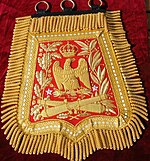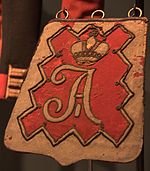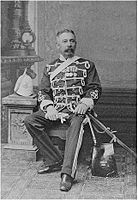Sabretache

A sabretache (derived from German: Säbeltasche) is a flat bag or pouch, which was worn suspended from the belt of a cavalry officer together with the sabre.
Origins
The sabretache is derived from a traditional Hungarian horseman's flat leather bag called a tarsoly.[1] Early examples have been found the tombs of Magyar warriors from the 10th century Conquest of Pannonia. They were often strengthened and decorated with silver plates and would have contained fire-making tools and other essentials.[2]
Military use
In the early 18th century, hussar cavalry became popular amongst the European powers, and a tarsoly was often a part of the accoutrements. The German name sabretache was adopted, tache meaning "pocket". It fulfilled the function of a pocket, which were absent from the tight fitting uniform of the hussar style. Part of the wartime function of the light cavalry was to deliver orders and dispatches; the sabertache was well suited to hold these. The large front flap was usually heavily embroidered with a royal cypher or regimental crest, and could be used as a firm surface for writing.[3] By the 19th century, other types of cavalry, such as lancers, also wore them.[4]
In the British Army, sabretaches were first adopted at the end of the 18th century by light dragoon regiments, four of which acquired "hussar" status in 1805.[5] They were still being worn in combat by British cavalry during the Crimean War; "undress" versions in plain black patent leather were used on active duty.[6] The Prussian Guard Hussars wore theirs in the Franco-Prussian War.[7] In most European armies, sabretaches were gradually abandoned for use in the field before the turn of the 20th century, but were retained by some regiments for ceremonial occasions.[8]
Sabretaches are now much sought after by collectors of militaria.[9]
Gallery
-
A Prussian hussar in 1763: his sabretache carries the cypher of Frederick the Great
-
Troopers of the French 1st Hussars in 1812, showing how the sabretache was attached to the sword belt
-
Sabretache worn by General Desvaux de Saint-Maurice, (died 1815) showing the crown and eagle of Napoleon I
-
A sabretache of the Russian Imperial Guard Hussar Regiment of the pattern worn from 1802 to 1825
-
The Commandant of the 11th Regiment of Bengal Cavalry (Lancers), part of the British Indian Army, with sabretache in 1867
-
An officer of the British 8th King's Royal Irish Hussars in 1880, showing the patent leather sabretache which was used on active duty
-
An officer of the British Royal Artillery with sabretache in 1901
-
A Danish Guard Hussar wearing a sabretache with his ceremonial uniform in 2012. It carries the cypher of Queen Margrethe II
References
- ^ Tarsoly Bearer's Homepage
- ^ András Róna-Tas, Hungarians and Europe in the early Middle Ages: an Introduction to Early Hungarian History, Central European University Press 1999, ISBN 963-9116-48-3 (P.136)
- ^ Canadian Military History Gateway: Royal Staff Corps officer's sabretache, circa 1820 Archived 2014-03-23 at the Wayback Machine
- ^ Sabretaches by Lt. Colonel J. B. R. Nicholson
- ^ Prebben Kannik, Military Uniforms in Colour, Blandford Press 1968 ISBN 0-7137-0482-9 (p.200)
- ^ J. B. R. Nicholson, The British Army of the Crimea, Osprey Publishing Ltd 1974, ISBN 0-85045-194-9 (p.15)
- ^ Michael Solka and Darko Pavlović, German Armies 1870-71 (1): Prussia, Osprey Publishing Ltd 2004, ISBN 1-84176-754-9 (p.20)
- ^ Nicholson (p.268)
- ^ James Alexander Mackay, An Encyclopedia of Small Antiques, Ward Lock, 1975 (p.164)








